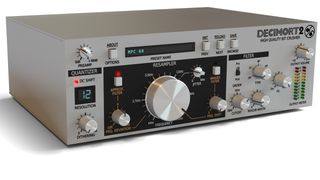Purists would argue that industrial is as much an ideology as it is a musical style. From vaguely similar 1970s roots as synthpop and punk, a cohort of avant-garde artists explored a very different approach, rejecting the traditional guitar-bass-drums approach to which most punk adhered and taking on a much harsher, more abrasive sound than the warmer, more song-based synthpop scene.
The 1976 foundation of the Industrial Records label by the Throbbing Gristle collective gave the genre its name, as much a surprisingly tongue-in-cheek nod to the idea of the music industry churning out records in industrial fashion as it was a reference to the industrial sounds involved.
Broadly speaking, the sound of industrial music is characterised by the collision of non-musical sounds (the ‘industrial’ aspect can be as obvious as clanging metal sounds but not necessarily quite so literal), often with samples (such as processed drum sounds) alongside synths, live instrumentation and heavily processed vocals, usually with disturbing lyrical themes relating to society and what might broadly be termed alternative lifestyles.
From that starting point, of course, all sorts of different directions can be taken. Even in the early days, the sounds of Throbbing Gristle records, for instance, were quite different to those of their even more electronic-focused Sheffield counterparts Cabaret Voltaire, let alone the more synthpop-adjacent Fad Gadget.
Early industrial music was very much rooted in avant-garde experimentalism, directly linked with the emergence of new technology – most obviously synths and then samplers, but also tape technology and effects.
Early industrial music was very much rooted in avant-garde experimentalism, directly linked with the emergence of new technology – most obviously synths and then samplers, but also tape technology and effects.
As technology has evolved, industrial has kept up the pace. Skinny Puppy, for instance, formed in 1982 when synth and sampling technology was relatively undeveloped, but they now use Eurorack modular synths extensively.
There are also industrial-related acts who eschew electronics altogether, such as Swans, who veer into industrial territory with traditional rock instruments.
The aesthetics of industrial are arguably nearly as important as the sound itself. Perhaps inevitably, a number of industrial artists have flirted with the iconography of fascism and societal deviance - in most cases for little more than shock value, but in some problematic cases with a sympathy for far-right ideology and what might be described as extreme sexual practices.
Industrial has splintered in various directions, with separate but closely related subgenres like industrial metal, rock, techno and many more. As is often the case, even leading exponents have questioned the term. As Ministry member Al Jourgensen put it: “I never worked in a construction site or an industrial site. What is industrial? ZZ Top uses drum programming and samples and stuff. Is ZZ Top industrial?”
What’s particularly noteworthy about industrial is that, despite its apparently quite uncommercial characteristics, the broader scene seems to spawn major commercial successes every few years, with acts like Nine Inch Nails, Orgy and Rob Zombie all achieving platinum album sales. Marilyn Manson even became a somewhat unlikely pop star around the release of his eponymous band’s hit 1996 album Antichrist Superstar.
That said, there’s a strong case that the biggest impact of industrial music on the wider world is the normalisation of a particular form of extreme experimentalism. The fact that Marilyn Manson can have hits as a pop artist and Trent Reznor is now one of the world’s leading soundtrack composers suggests that industrial music succeeded - at the very least - in disrupting the traditionalism of the music industry.
Two industrial approaches to music production
Processing

Musicians working in all genres can take a cue from industrial in terms of sound design and production techniques. Processing is an obvious starting point, encompassing a huge range of approaches but fundamentally rooted in experimentation. Vocal processing in particular has been a mainstay of industrial since the very early days, with vocalists employing a range of techniques for live performance and studio recording.
Perhaps take distortion as a starting point, but the main point is to think outside the box: could your synth go through a guitar pedal? What would a guitar sound like through a cheap speaker and microphone? Why not try introducing some of the classic ’70s industrial techniques to your music, like DIY tape loops?
Lo-fi sampling

Low-resolution samplers are always a good choice in any style of music, whether you’re channelling the authentically gritty sound of ’80s industrial or just looking to inject character into your productions.
Prices of the more sought-after models like E-mu Emulators have risen substantially in recent years, but something like the Emax - used extensively by Trent Reznor and KMFDM - is more affordable. Or you can achieve similarly gritty results with software.
We like D16’s Decimort for bit-crushing and Togu Audio Line’s TAL-Sampler for a slightly more advanced option, with the ability to recreate the artefacts and character of ’80s samplers.




